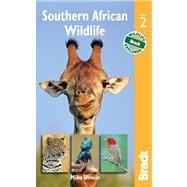
Note: Supplemental materials are not guaranteed with Rental or Used book purchases.
Purchase Benefits
What is included with this book?
The New copy of this book will include any supplemental materials advertised. Please check the title of the book to determine if it should include any access cards, study guides, lab manuals, CDs, etc.
The Used, Rental and eBook copies of this book are not guaranteed to include any supplemental materials. Typically, only the book itself is included. This is true even if the title states it includes any access cards, study guides, lab manuals, CDs, etc.
[From ‘Looking for animals’]
Anticipating an animal’s needs will help you to find it. Water, particularly in the dry season and in arid habitats, attracts everything from thirsty herds of antelope to basking terrapins and foraging waders. Look for potential food sources: a large herd of buffalo is a magnet to lions, whose kill draws scavengers such as vultures and hyenas; elephants go mad for marula trees in season, while their droppings are picked through by francolins, baboons and dung beetles. Raptors flock to termite swarms, storks and jackals follow grass fires for the exodus of rodents and reptiles, and a fruiting sycamore fig provides a real bonanza, with hornbills, monkeys and louries flocking to the canopy by day, bushbabies and fruitbats arriving by night and bushbuck foraging for pickings beneath.
[from birds]
In the arid west, dusk and dawn at the waterhole are heralded by a soft ripple of whistled calls, as sandgrouse wheel swiftly in. The noise swells as more birds arrive in the half-light, each landing a few metres back from the waterhole before shuffling forward to the water’s edge. Thirst quenched, the first birds take to the air with a clatter of wings and disappear towards the dark horizon, while the next rank presses forward to take their place.
Sandgrouse are pigeon-sized birds, perfectly adapted to the arid conditions of the Kalahari and Namibia. Males are ornately patterned, while females have the typical cryptic camouflage of a ground nester. Their daily visits to water are not only to slake their own thirst. During the breeding season, males will wade in belly-deep to soak up water with their specially-adapted breast feathers, before returning with their precious cargo to the young on the nest, sometimes over 50km away.
There are four species of sandgrouse in southern Africa. Most common in the west is the Namaqua sandgrouse (Pterocles namaqua), easily identified by the male’s long pointed tail. This species is joined at waterholes by Burchell’s sandgrouse (Pterocles burchelli), whose ochre plumage is sprinkled with fine white spots. Doublebanded sandgrouse (Pterocles bicintus) also occur in dry woodland further east. The male is identified by black and white bars on his breast and forehead.